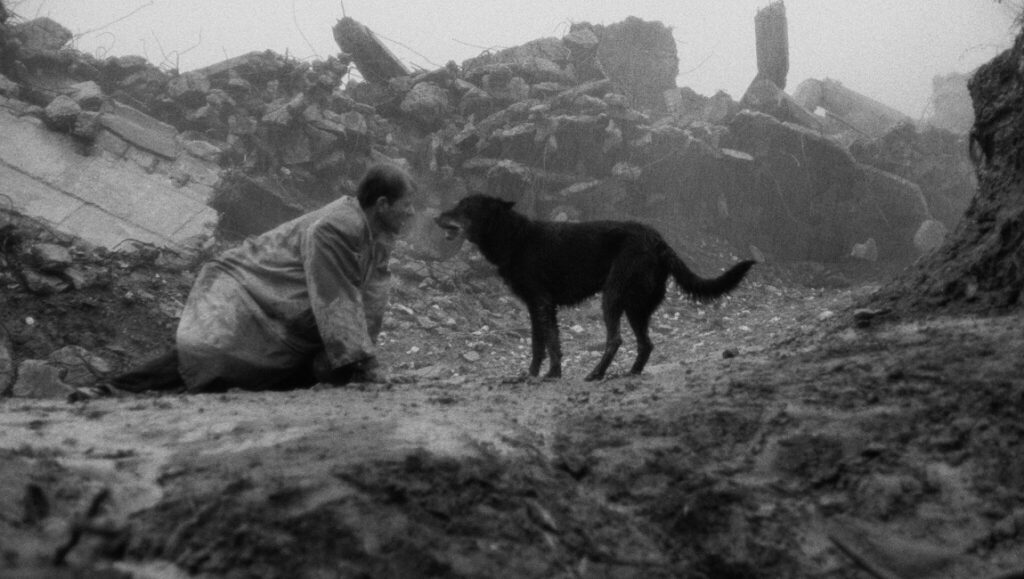For a brief period of time in the early-to-mid 2000s, there was perhaps no more exciting international director than Bela Tarr. Advocates like Jonathan Rosenbaum, Susan Sontag, and J. Hoberman sang the praises of the monumental, seven-hour Satantango, at that time a phantom object of cinephilic obsession almost impossible to see outside of film festivals and special one-off screenings. Werckmeister Harmonies would also become a cause celebre upon its release in 2000, cementing Tarr’s reputation as a unrepentant miserablist with a keen sense of dreary ennui coupled with a complete mastery of complicated, seemingly never-ending long takes. It’s not clear exactly when the tides turned; 2007’s The Man From London didn’t make much of a splash, and has never garnered a proper home video release to help rehabilitate its reputation, while The Turin Horse (2011) became notable mostly due to Tarr announcing his retirement immediately after its completion. Maybe our collective dread at the turn-of-the-millennium had worn off; it certainly didn’t help that Tarr became part of the insipid “cultural vegetables” debate, a useless op-ed bromide that sparked one of the worst, laziest catch phrases of the 2010s.
In any case, we come here to praise Tarr, not to bury him. The intrepid folks at Arbelos Films have recently released restored versions of Satantango and Damnation, the latter generally agreed upon to be Tarr’s first “mature” work. Barely released in 1988, it’s as good a place as any to start for the uninitiated. His previous feature, Almanac of Fall (1984), while a fine work in and of itself, ultimately represents a fascinating road not taken, a kind of stylistic cul de sac. So too does his 1983 television adaptation of Macbeth, which plays like a rough draft for the formal concerns that would come to fruition with Damnation and then get refined and expanded upon in the later works. Indeed, Damnation is a series of firsts for Tarr; his first film written with the novelist Laszlo Krasznahorkai, who would become his co-writer on each subsequent film project; his first time working with cinematographer Gabor Medvigy, who would go on to shoot Satantango and Werckmeister; only his second collaboration with musician Mihaly Vig, who scored Almanac of Fall and every feature afterwards; and, of course, Tarr’s most important collaborator, Agnes Hranitzky, credited as editor on all of his works (including the early trilogy of Family Nest, The Outsider, & The Prefab People) before becoming the credited co-director on each subsequent feature. It’s hard to discern her exact contributions, besides the fact that she seems essential to, and inseparable from, Tarr’s peculiar achievements.
Damnation is, at first blush, incredibly simple, a standard noir template that follows drunk layabout Karrer (Miklos Szekely) as he pines for a married woman, played by Vali Kerekes. She performs at a local bar, the Titanik, where Karrer drinks his days away in a stupor of cheap brandy. After the owner attempts to bring him in on a smuggling job, Karrer senses an opportunity — declining the job for himself, he instead convinces his lover’s husband, played by Gyorgy Cserhalmi, to do the job in his stead. There’s not much more plot than that; instead, Tarr films everything as a series of isolated vignettes that survey the entirety of a collapsed, ruined society. Transpiring entirely in a small mining town, the landscape is a blasted, hollowed-out husk, devoid of life beyond a few key characters and the occasional stray dog. The film might as well be taking place on the surface of the moon. The first shot of the movie captures a complex system of elevated mine carts crisscrossing the sky, before the camera tracks back and then dollies to frame a perfect silhouette of a man through a window. This becomes a recurring motif, Tarr juxtaposing human figures with this machinery in the background, inextricably linking the body with the automated back-and-forth of the trolley system.
Thematically, it’s a fairly clear indictment of alienated labor, with the characters forever under the shadow of capital moving over their heads while they wallow in sex and booze down on the ground. Not quite ready to tackle the extremely complicated camera movements of Satantango, here Tarr favors slow pans, starting the camera on a face or body and then slowly moving the camera to the left or right as it takes in an entire room. Curiously, he doesn’t zoom the camera in or out, which leads to extreme contrasts between foreground and background. Tarr seems determined to mire his audience in the same slow, sticky morass that his characters are trapped in. It’s a bold gambit, a precise stylization that reaches its peak in the long, unbroken sequence surveying the drunk doctor in Satantango and the opening shot of The Turin Horse, in which a horse pulls a carriage through a windstorm in seeming real-time. Abstraction and utilitarianism go hand in hand with Tarr, a doomed romantic who is naive enough to believe in love but experienced enough to realize that the world is stacked against us. Far from boring, Tarr instead invites us to commiserate with his characters. He might be miserable, but he’s no nihilist — in the end, the act of creation is reason enough to go on.
Part of Kicking the Canon – The Film Canon.


Comments are closed.